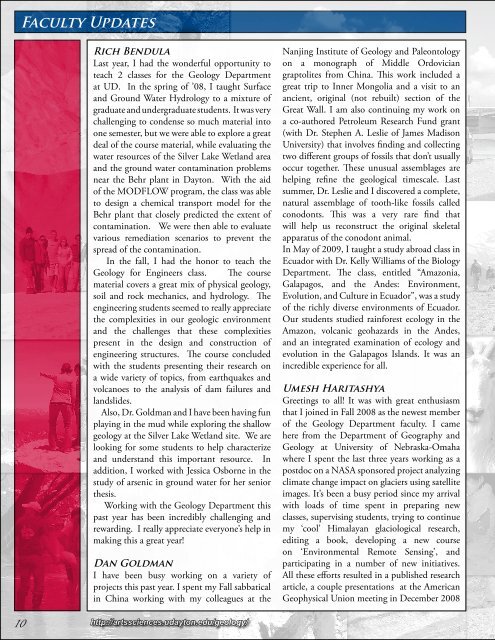View this issue (pdf) - University of Dayton
View this issue (pdf) - University of Dayton
View this issue (pdf) - University of Dayton
Create successful ePaper yourself
Turn your PDF publications into a flip-book with our unique Google optimized e-Paper software.
Faculty Updates<br />
Rich Bendula<br />
Last year, I had the wonderful opportunity to<br />
teach 2 classes for the Geology Department<br />
at UD. In the spring <strong>of</strong> ’08, I taught Surface<br />
and Ground Water Hydrology to a mixture <strong>of</strong><br />
graduate and undergraduate students. It was very<br />
challenging to condense so much material into<br />
one semester, but we were able to explore a great<br />
deal <strong>of</strong> the course material, while evaluating the<br />
water resources <strong>of</strong> the Silver Lake Wetland area<br />
and the ground water contamination problems<br />
near the Behr plant in <strong>Dayton</strong>. With the aid<br />
<strong>of</strong> the MODFLOW program, the class was able<br />
to design a chemical transport model for the<br />
Behr plant that closely predicted the extent <strong>of</strong><br />
contamination. We were then able to evaluate<br />
various remediation scenarios to prevent the<br />
spread <strong>of</strong> the contamination.<br />
In the fall, I had the honor to teach the<br />
Geology for Engineers class. The course<br />
material covers a great mix <strong>of</strong> physical geology,<br />
soil and rock mechanics, and hydrology. The<br />
engineering students seemed to really appreciate<br />
the complexities in our geologic environment<br />
and the challenges that these complexities<br />
present in the design and construction <strong>of</strong><br />
engineering structures. The course concluded<br />
with the students presenting their research on<br />
a wide variety <strong>of</strong> topics, from earthquakes and<br />
volcanoes to the analysis <strong>of</strong> dam failures and<br />
landslides.<br />
Also, Dr. Goldman and I have been having fun<br />
playing in the mud while exploring the shallow<br />
geology at the Silver Lake Wetland site. We are<br />
looking for some students to help characterize<br />
and understand <strong>this</strong> important resource. In<br />
addition, I worked with Jessica Osborne in the<br />
study <strong>of</strong> arsenic in ground water for her senior<br />
thesis.<br />
Working with the Geology Department <strong>this</strong><br />
past year has been incredibly challenging and<br />
rewarding. I really appreciate everyone’s help in<br />
making <strong>this</strong> a great year!<br />
Dan Goldman<br />
I have been busy working on a variety <strong>of</strong><br />
projects <strong>this</strong> past year. I spent my Fall sabbatical<br />
in China working with my colleagues at the<br />
Nanjing Institute <strong>of</strong> Geology and Paleontology<br />
on a monograph <strong>of</strong> Middle Ordovician<br />
graptolites from China. This work included a<br />
great trip to Inner Mongolia and a visit to an<br />
ancient, original (not rebuilt) section <strong>of</strong> the<br />
Great Wall. I am also continuing my work on<br />
a co-authored Petroleum Research Fund grant<br />
(with Dr. Stephen A. Leslie <strong>of</strong> James Madison<br />
<strong>University</strong>) that involves finding and collecting<br />
two different groups <strong>of</strong> fossils that don’t usually<br />
occur together. These unusual assemblages are<br />
helping refine the geological timescale. Last<br />
summer, Dr. Leslie and I discovered a complete,<br />
natural assemblage <strong>of</strong> tooth-like fossils called<br />
conodonts. This was a very rare find that<br />
will help us reconstruct the original skeletal<br />
apparatus <strong>of</strong> the conodont animal.<br />
In May <strong>of</strong> 2009, I taught a study abroad class in<br />
Ecuador with Dr. Kelly Williams <strong>of</strong> the Biology<br />
Department. The class, entitled “Amazonia,<br />
Galapagos, and the Andes: Environment,<br />
Evolution, and Culture in Ecuador”, was a study<br />
<strong>of</strong> the richly diverse environments <strong>of</strong> Ecuador.<br />
Our students studied rainforest ecology in the<br />
Amazon, volcanic geohazards in the Andes,<br />
and an integrated examination <strong>of</strong> ecology and<br />
evolution in the Galapagos Islands. It was an<br />
incredible experience for all.<br />
Umesh Haritashya<br />
Greetings to all! It was with great enthusiasm<br />
that I joined in Fall 2008 as the newest member<br />
<strong>of</strong> the Geology Department faculty. I came<br />
here from the Department <strong>of</strong> Geography and<br />
Geology at <strong>University</strong> <strong>of</strong> Nebraska-Omaha<br />
where I spent the last three years working as a<br />
postdoc on a NASA sponsored project analyzing<br />
climate change impact on glaciers using satellite<br />
images. It’s been a busy period since my arrival<br />
with loads <strong>of</strong> time spent in preparing new<br />
classes, supervising students, trying to continue<br />
my ‘cool’ Himalayan glaciological research,<br />
editing a book, developing a new course<br />
on ‘Environmental Remote Sensing’, and<br />
participating in a number <strong>of</strong> new initiatives.<br />
All these efforts resulted in a published research<br />
article, a couple presentations at the American<br />
Geophysical Union meeting in December 2008<br />
10<br />
http://artssciences.udayton.edu/geology/
















